Review Article - (2023) Volume 8, Issue 10
Bekesys Hearing Theory
Received Date: Sep 20, 2023 / Accepted Date: Oct 20, 2023 / Published Date: Oct 25, 2023
Abstract
Georg von Békésy (1899-1972), as a Hungarian citizen, was awarded the 1961 Nobel Prize in Medicine for his experiments in Hungary (1923-1946) “for his discoveries of the physical mechanisms of stimulation within the cochlea”. The most significant element of Békésy’s oeuvre is the observation and description of the mechanical processes in the inner ear and the creation of a new theory on the nature of hearing. He was the first to produce a model that truly resembles the inner ear. His success is due to detailed studies on the constituents of the cochlea and a large number of measurements. It is also very important to identify how the mechanism of neural inhibition in the ear contributes to the distinction of “signal” from “noise”. For Békésy, the biophysical approach was decisive, and he connected the three sense organs (ear, skin, eye) with each other. In his oeuvre, he also combined his research in physics, communications and medicine, as well as his scientific work with art.
Keywords
Georg von Békésy, Nobel Laureate, Hearing theory, Character
Introduction
Georg von Békésy as a descendant of a noble family from Transylvania. The family was delighted when nobility and privileges were later-on May 24, 1913-extended to dr. Sandor Bekesy and his children [1].
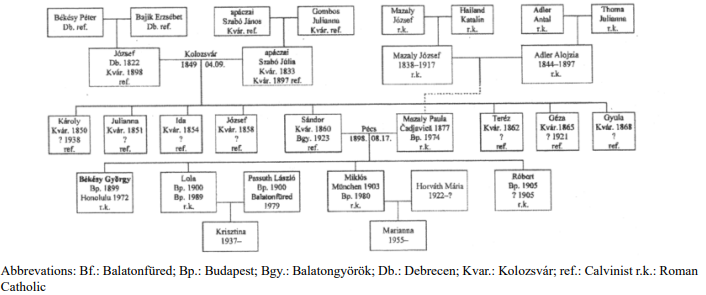
Figure 1: The genealogy of Georg von Bekesy was elaborated by Janos Vincze
Hearing Theory
The ear transforms soft mechanical vibration of air particles into electrical signals, which reach the appropriate part of the cerebral cortex for processing by means of auditory nerves. The cerebellum interprets these complicated signals by determining pitch, tone, loudness, and placement of the sound source. According to the frequency, the sounds classify as follows: infrasounds, (ν<16 Hz), proper sounds (16 Hz<ν<20 kHz), ultrasounds (ν>20 kHz). The infrasounds and the ultrasounds cannot be perceived by the human ear [2].
In the human middle ear are three tiny bones in the tympanic cavity between the eardrum and the oval opening: malleus (6-8 mm), incus (7 mm) and stapes (3x3 mm2). The deflections of the eardrum are transferred to the base of the stapes by the lifting action of the auditory bone chain. Due to the fact that the functional surface of the eardrum is 55 mm2 and that of the stapes base is 3.2 mm2, the pressure at the base of the stapes is 18 times higher than that of the eardrum (55: 3.2=17). This ratio corresponds to a 24.5 dB increase in sound pressure. To this must be added 2.2 dB, since one crus of the auditory bone chain (one arm of the elevator) is one handle of the malleus, the other crus (the other arm of the elevator) is the long crus of the incus, 1.3 times longer than the handle of the malleus. Thus, the voice guidance system of the middle ear: It causes a pressure increase of 24.5+2.2=26.7 dB. From all this we can conclude that the middle ear acts as a mechanical transformer [3].
The stapes base moves-after Békésy around two axes: for weaker sounds-rotates around its transverse axis (Figure 2a.);
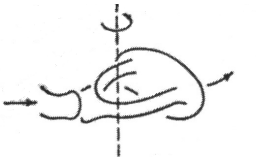
Figure 2a: Weaker sounds-rotates around its transverse axis
In case of a strong sound-it moves around its longitudinal axis, then the amplitude of vibration is smaller (Figure 2b).
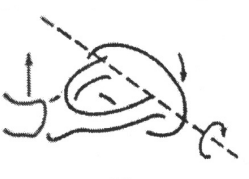
Figure 2b: Strong sound-it moves around its longitudinal axis
Bekesy prove that wherever the sound stimulus comes from (through the oval window or by bone conducting), it creates a surface wave from the oval window towards the tip of the cochlea. The propagation speed of the surface wave depends on the increasing width and looseness of the membrana basilaris and, as a result, decreases with distance from the oval window (45 m/s-2 m/s) [4]. Surface waves caused by high sounds occur in a narrow, tight area near the windows, while fluctuations caused by deep sounds occur at the far, wider, loose ends. At deep sounds, the fluctuation fills the entire length of the membrana basilaris, while at high sounds it fills only the front. The vibrations of the membrana basilaris bend the hair cells of the organ of Corti affected by the traveling waves, creating an electrical potential difference [5].

Figure 3: The relative amplitude of the displacement of the basilar membrane serves as a function of the distance from the stapes for many different frequencies
He designed a hearing tester at the Experimental Station of the Post. This device is called the “Békésy audiometer” (Figure 4), it was built in Hungary.
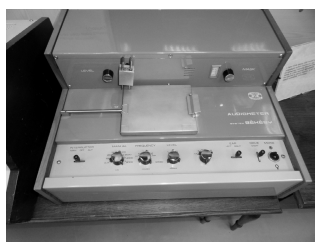
Figure 4: Bekesy’s audiometer
In 1961, nobleman Georg von Békésy received the Nobel Prize (Figure 5) in Medicine: “for his discoveries of the physical mechanisms of stimulation within the cochlea”. The results of this research were carried out in Budapest, and he also published his results before World War II. So it is very important to note that Békésy received the Nobel Prize in Medicine for his research in Hungary.
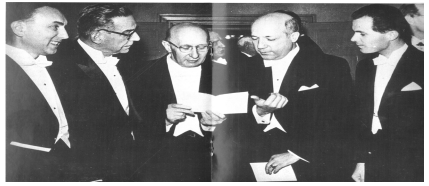
Figure 5: The Nobel-prizes in 1961: Robert Hofstadler, Ivo Andric, Bekesy Gyorgy, Melvin Calvin and Rudolf Luwig Mössbauer
Georg von Bekesy’s
Personality He did not put much emphasis on his appearance in the workplace where he did his research. He was clean and tidy. He did not dress in fashionable, impressive suits [6]. He wore a sand-colored suit every day. The style of dress is a sensitive expression of identity, but he did not focus on the outside, it was the inside that mattered to him. Dressing up did not compensate for knowledge, as it often did for others. He was smiley, but reserved. He did not develop friendly relations with his colleagues. Constantly innovating, he sought and pushed the “boundaries” of knowledge, often shocking his contemporaries. He embodied the overcoming of his own physical limitations and always strived for reality at the cost of the greatest struggles. He remained withdrawn in spite of the multitude of achievements spanning centuries, in a vast space, fueled by a multi-directional vocation. He found solace in his own inner world among the fairy creatures of creative imagination. Usually this state of affairs lasts-for many years, decades-until “foreigners” discover others, start writing about him, dissecting his life moment by moment, what he did, why, with whom, etc. [7]. Then everyone is his “friend,” most contemporaries remember stories from half a century ago that no one remembers (because they never happened), but they make great stories. Then, after they’ve pulled out all the hair, taken it apart, written down all the non-existent “news”, they take him off the air, forget about him. As soon as the child gets bored of the doll and starts doing something else.
His personality was characterized by a scholarly ambition, a responsible way of thinking, but lacked ostentation, assertive¬ness, a desire to prove himself or to be seen. These qualities have decisively influenced all his choices and the development of his career.
There is also an optimum age for marriage, with some experts suggesting an upper limit of 28 years [8]. If the individual does not start a family by this time, it will be doubtful whether they will be able to form a family, because this is the time limit during which one party can still develop and adapt to the other, but later on their character will become “ossified”, their qualities and habits will become rigid and they will be unable to adapt to another party [9]. But marriage is a constant exercise in compro¬mise, on the part of both parties. Bekesy was smiley, but reserved.
Georg von Békésy is an intellect, an individual, a perso¬nality, a genius, a highly creative, innovative scientist, a thinker beyond his years and era. Genius is commonly defined as someone who “starts to think when other stop!” That is what makes him a mastermind: he forms and creates something new [10].
He is standing alone at the top of the mountain peak. He is on the highest spot, which, given his position, leads to loneliness. He can find common ground only with someone standing at the top of another mountain, but as the two geniuses go up the moun¬tain, they move away from each other horizontally and vertically from their average social environment [11].
Bekesy’s personality reflects competent interpersonal beha¬vior. The noble family, his parents raising him from the perspective of a university professor, the global intellectual milieu, motivation and emotional control exemplify social attitu¬des and autonomous behavior. For this reason, the literature argues that cultured environment and creativity are interrelated, and the expectation for high standards both for himself and others is essential for intellectual families. The noble families passed along, in addition to the centuries-old legacy of traditions, the respect for one another (ascendant, descendant, contemporary at the horizontal interpersonal level), patriotism, desire for know¬ledge, need for development (benevolence, sociability, ability) and endless written and unwritten expec¬tations, that, once they were met, allowed him to preserve his “identity” for a lifetime, and to stand out even from the bour¬geoisie. The nobleman, the aristocrat recognizes his intellectual relatives even in distant sounds, he recognizes charismatic people. This characterizes him on a professional level as well [12].
The Genius
Georg von Bekesy is an intellect, an individual, a perso¬nality, a genius, a highly creative, innovative scientist, a thinker beyond his years and era. Genius is commonly defined as someone who “starts to think when other stop”. That is what makes him a mastermind: he forms and creates something new.
He is standing alone at the top of the mountain peak. He is on the highest spot, which, given his position, leads to loneliness. He can find common ground only with someone standing at the top of another mountain, but as the two geniuses go up the mountain, they move away from each other hori¬zontally and vertically from their average social environment [13].
It is very frustrating to realize that the genius is not un¬derstood, due to the limitations related to knowledge, and becomes abandoned and isolated. The question to be resolved is whether he was the one who did not find his place in company, and would withdraw from this group that restricted his freedom and wasted his time, where he could not progress and gain additional knowledge, or he was slowly excluded even from companies with higher standards than the average as these followed their own principles, because he disrupted the usual order, for instance, they did not understand his reasoning, they felt superiority in his explanations, and their minority complex awakened in his company.
In social life, interactions on multiple levels are independent of the individual, and adhere to common norms. He internalized this impersonal adaptation in his childhood as a requirement of the intellectual atmosphere at home. Education has a dete¬rmining character [14]. The parents provided the intellectual at¬mosphere that defines everything both intellectually and emo¬tionally, as well as the parental home characterized by the sophistication of perfection as living environment; while the material environment was a specimen of aesthetic experience, and thus an indicator of material sophistication: the house, the apartment, their appearance and interior decoration.
Bekesy’s personality reflects competent interpersonal beha¬vior. The noble family, his parents raising him from the perspective of a university professor, the global intellectual milieu, motivation and emotional control exemplify social attitudes and autonomous behavior. For this reason, the lite¬rature argues that cultured environment and creativity are in¬terrelated, and the expectation for high standards both for himself and others is essential for intellectual families. The noble families passed along, in addition to the centuries-old legacy of traditions, the respect for one another (ascendant, descendant, contemporary at the horizontal interpersonal level), patriotism, desire for knowledge, need for development (benevolence, sociability, ability) and endless written and unwritten expectations, that, once they were met, allowed him to preserve his “identity” for a lifetime, and to stand out even from the bourgeoisie. The nobleman, the aristocrat recognizes his intellectual relatives even in distant sounds, he recognizes cha¬rismatic people [15].
Both in the social and workplace environment, he needed to find out the possibilities and variants of the question and the solution. There were many more ordeals for him every day. He had to go beyond the unique, professional and general envi¬ronmental incomprehension, and he had to ignore, otherwise the large mass of average people could have dragged him down to the level of the majority. By overviewing the ideas, he may have summed up what, how and for how long he needed to do, what he was going through, how he was affected, and the way he should have reacted to everything. Sometimes he is anxious, but he finds hope when he changes jobs, because as soon as he moves into another environment, most often (according to his autobiography) he soon reconciles. He fit into his environment, because - as the proverb goes-it is better to bend than break, of course up to a certain moral extent [16].
It is worth reflecting upon the fact that after a brilliant doctoral dissertation, he got rejected at several jobs, and was located at the Experiment Station of the Hungarian Post Office in Budapest, and therefore started working on a whole new research topic. At the end of World War II, both of their laboratories were destroyed by the American-English bomb attacks. He was forced to leave Hungary, and he rebuilt his lab with one briefcase, without a single device, but with a new topic in the United States of America. This lab was also consumed by fire, along with his notes. At the end of his life, he had the conditions to research a new topic in Honolulu, in a new laboratory. He did not give up, not once. In the meantime, there was no wife, relative, friend, acquaintance beside him, and he always needed to adapt to new people.
In our opinion, Bekesy’s personality clearly carries all the characteristics of geniuses. He had enormous intellectual capacity, but at the same time, he was extremely modest and even humble in research. He noticed in everyday events the things others had missed. He built his experiments thoroughly, without making up the results in advance, but letting the practical results show the way to the theoretical interpretations. Bekesy’s activities took place in the constant headwind of his environment.
He is an outstanding representative of the figure of the interdisciplinary thinker: he held a degree in chemistry, a doctorate in physics and a Nobel Prize in Medicine for the hearing problems in living organisms as a physicist and engineer.
Georg von Bekesy was not familiar with the attitude of compromise in scientific research, and he was a genius in the everyday life as well, because when asked:
• Why haven’t you married?
• He responds:
I am married, my wife is science!
References
1. Vincze, J. (2019). Georg von Békésy. NDP K., Budapest, 2019.
2. Békésy von, G. (1928). Zűr Theorie des Hörens; die Schwingungsform dér Basilarmembran. Phys Z, 29, 793- 781.
3. Békésy von, G. (1929). Zűr Theorie des Hörens; über die Bestimmung des einem reinen Tonempfinden entsprechenden Erregungsgebie- tes dér Basilarmembran vermittelst Ermüdungs-ercheinungen. Phys Z, 30, 115-125.
4. Békésy von, G. (1929). Zűr Theorie des Hörens; über die eben merkbare Amplitu- den- und Frequenzánderung eines Zones: Theorie dér Schwebungen. Phys Z, 30, 721-745.
5. Bekesy von, G. (1930). Zűr Theorie des Hörens; über das Richtungshören bei einer Zeitdifferenz oder Lautstárkenungleicheit dér beiderseitigen Schalleinwirkungen. Phys Z, 31, 857-868.
6. Vincze, J., & Vincze-Tiszay, G. (2020). The Biophysical Modeling of the Seven-Dimensional. Man Intern J Recent Scientific Res, 11(7), 39173-39176.
7. Edward, T., & Hall, E.T (1966). The hidden Dimension. Anchor Books, Doubleday, New York, 1966.
8. Ritchey, F. (2000). The statistical imagination. Elementary statistics for the social sciences. McGraw-Hill, Boston.
9. Vincze, J., & Vincze-Tiszay, G. (2020).The Biophysical Modeling of the Biopsychological System. J Progressive Res Social Sci 9(3), 733-738.
10. Vincze, J., & Vincze-Tiszay, G. (2020). Some Aspects of Sciences from the Biophysical Point of View. Intern. J Software Hardware Res Eng, 8(9), 103-108.
11. Vincze, J., & Vincze-Tiszay, G. (2020). The Biophysical Modeling of the Biopsychological System. J Progressive Res Social Sciences 9(3), 733-738.
12. Vincze, J., & Vincze-Tiszay, G. (2020). The Human Organism is a Bioppsychological System. Technium, 2(7), 29-36.
13. Vincze-Tiszay, G. (2007) I love You with Lovely love. NDP P., Budapest, 2007.
14. Vincze, J., & Vincze-Tiszay, G. (2020). Prof. Dr. nob. georg von Békésy Nobel Laurate. Humanities Social Sciences, 8(5), 145-150.
15. Statt, D.A. (1988). The concise Dictionary of Psychology. Routledge, London-New York, 1998. 16. Vincze-Tiszay, G. (2020). Psichological Brevier. I–II–III. NDP P. Budapest, 2020.
Copyright: © 2025 This is an open-access article distributed under the terms of the Creative Commons Attribution License, which permits unrestricted use, distribution, and reproduction in any medium, provided the original author and source are credited.



